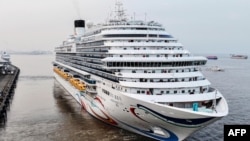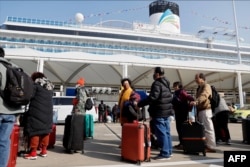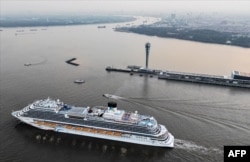On January 1, China’s first domestically manufactured cruise ship, the Adora Magic City, left its dock in Shanghai on a seven-day voyage to South Korea and Japan.
Featuring international cuisine, state-of-the-art theaters and large duty-free shops, along with a mahjong lounge and hotpot restaurant, the Adora Magic City is aimed at serving China’s expanding middle class.
Chinese state media hailed the cruise ship as a major milestone for the Chinese shipbuilding industry and “a crown jewel.”
In a February 13 post on its X account, Chinese state media’s Global Times quoted China’s Association of the National Shipbuilding Industry as saying:
“After delivering the first home-grown large cruise ship Adora Magic City, China has the ability to build all types of maritime ship products.”
That is false.
The Adora Magic City is heavily reliant on foreign technology.
30% made in China
The Adora Magic City was built by Shanghai Waigaoqiao Shipbuilding Corporation, a subsidiary of the state-owned China State Shipbuilding Corporation (CSSC).
The cruise ship weighs 135,500 metric tons, is 323 meters long and has a capacity of 5,246 passengers, according to the industry website Ship Technology.
International suppliers provided many of the Adora Magic City’s components.
The Adora Magic City’s chief designer, Chen Gang, told domestic media that out of the 110 suppliers Shanghai Waigaoqiao worked with, roughly 30% were Chinese companies, while the rest were foreign companies.
High proportion of foreign technology
The Adora Magic City is operated by CSSC Carnival, a joint venture between Carnival Corporation, a British-American cruise operator, and China State Shipbuilding Corporation (CSSC), China’s state-owned shipbuilding conglomerate.
In 2016, CSSC Carnival signed a contract with Italian shipyard Fincatieri, which “granted a technology license of the ship model platform and provides a series of technical services” to CSSC’s Shanghai Waigaoqiao Shipbuilding Corporation.
Those technical services included “project management activities, supply chain management and sales of fundamental systems and components.”
“The on board design will be tailored for the specific tastes of the Chinese clients,” Fincantieri said in a 2020 press release.
Meanwhile, Finnish maritime technology company Wartsila provided the Adora Magic City with automation and control systems, a valve control system, low-location lighting, a navigation system, an engine and bridge control-room console, and smart motor control units.
ABB, the Swiss engineering and technology group, provided the cruise ship’s power and propulsion system.
The Adora Magic City’s chief designer, Chen Gang, told CarCaijing, a Chinese media outlet focusing on technology and finance, that China currently lacks a complete cruise manufacturing supply chain, and that domestic supplies couldn’t meet the high-end design requirements for luxury vessels.
He added that Europe has formed a mature cruise-ship supply chain with its own first-tier and second-tier supplier system and a standards system, which makes it difficult for Chinese domestic supplies to find a place in the current supply chain.
Among the world’s largest shipyards are Fincantieri in Italy, Meyer Werft in Germany and STX Europe, with locations in Finland and France.
And even if domestic supplies meet the industry standard, their price is not necessarily competitive, according to Chen, since “raw materials may have to be imported and there’s no scale effect.”
Nevertheless, the Adora Magic City’s maiden voyage demonstrates China’s ambition to expand regionally and eventually join the cruise ship manufacturing industry.
The current joint venture model fits China’s usual method for technology acquisition. Beijing has a track record of requiring foreign investors in certain industries to form joint ventures with Chinese partners in order to access the China market.
James Andrew Lewis, a technology policy expert at the Center for Strategic and International Studies (CSIS), a Washington -based think tank, noted in a report last November that foreign direct investment and joint ventures are a leading source of technology transfers for China.
In the joint venture model, Chinese companies gain access to key technological and managerial experience, and eventually beat their foreign counterparts at their own game by producing, with state support, at scale and lower cost.









